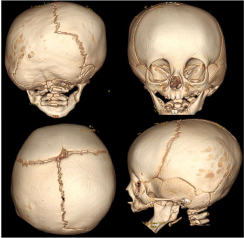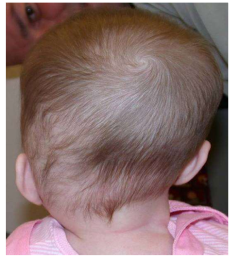Lambdoid Suture Synostosis (Posterior Plagiocephaly)
Lambdoid suture craniosynostosis is a condition that occurs when the lambdoid suture in an infant’s skull closes prematurely. This affects the shape of the baby’s head and can lead to various issues. In particular, causes of lambdoid suture craniosynostosis may include genetic factors or environmental influences. Its symptoms manifest as a noticeable skull deformity. In this article, we will provide detailed information on symptoms of lambdoid suture craniosynostosis, diagnosis, and treatment of lambdoid suture craniosynostosis in subsequent stages.
What Is Lambdoid Suture Craniosynostosis?
Lambdoid suture craniosynostosis is a congenital anomaly that arises when the lambdoid suture in an infant’s skull closes earlier than normal. Because this suture is critical for brain development both before and after birth, its premature closure deforms the skull and can potentially impair brain growth.
This condition causes a flattening of the back of the skull, resulting in an abnormal head shape. Lambdoid suture craniosynostosis is typically detected at birth or during infancy when routine checks or concerns—such as a “flat spot”—arise. The deformity gives the head an asymmetrical appearance. Early closure can also increase intracranial pressure, leading to serious complications for brain development.
This specific type of craniosynostosis accounts for approximately 5–15% of all cases. In children, it is linked to a variety of genetic, environmental, and multifactorial causes. Therefore, causes of lambdoid suture craniosynostosis include genetic predisposition, environmental exposures, and certain complications during pregnancy.
Diagnosis is a crucial step. It is usually made via physical examination, visual assessment, and CT imaging. Physicians focus on skull shape abnormalities and asymmetry to confirm the condition. With early diagnosis and appropriate treatment, potential brain development issues can be minimized, ensuring healthy growth.
Causes of Lambdoid Suture Craniosynostosis
Causes of lambdoid suture craniosynostosis are often considered idiopathic—meaning no single cause is identified. However, certain genetic and environmental factors have been implicated. Experts note that premature closure of the lambdoid suture may be associated with:
| Cause | Description |
|---|---|
| Genetic Factors | Occurs more frequently in infants with a family history of craniosynostosis, suggesting a genetic component. |
| Environmental Influences | Exposure during pregnancy to certain factors (e.g., medications, alcohol use, nutritional deficiencies) can increase risk. |
| Syndromic Conditions | Associated with genetic syndromes such as Apert, Crouzon, or Pfeiffer, in which multiple sutures may close early. |
| Maternal Health Issues | The mother’s health, nutrition, and medical conditions during pregnancy can affect risk. |
| Prenatal Trauma | Trauma during pregnancy may raise the likelihood of suture closure anomalies. |
Additionally, some studies suggest that increased time spent lying on one side may contribute to asymmetry and promote lambdoid suture closure. In conclusion, the causes of lambdoid suture craniosynostosis involve complex interactions among genetic, environmental, and maternal health factors. Early detection and intervention are critical to support healthy development.
Symptoms of Lambdoid Suture Craniosynostosis
Symptoms of lambdoid suture craniosynostosis present as noticeable skull deformities in infants. These include:
- Asymmetrical Skull Shape: The back of the head flattens on the affected side, creating a noticeable asymmetry with a bulge on the opposite side.
- Ear Position Changes: The ear on the affected side often appears pushed forward due to underlying bone deformity.
- Effects on Brain Development: Premature suture closure can impair brain growth, increase intracranial pressure, and lead to headaches, attention difficulties, or learning challenges.
- Facial Asymmetry: Expected facial symmetry may be disrupted, affecting social interactions and self-image.
- Fontanel Changes: The soft spots (fontanelles) may develop unusually or harden prematurely, making the condition more apparent.
These symptoms of lambdoid suture craniosynostosis should be monitored carefully, and any concerns warrant prompt evaluation by a healthcare professional. Early diagnosis and treatment are essential for optimal outcomes.
Diagnosis of Lambdoid Suture Craniosynostosis
Diagnosis of lambdoid suture craniosynostosis is a critical process for early detection of skull shape anomalies. The evaluation begins with a physical exam and is typically confirmed within the first few months of life.
During the initial assessment, the physician carefully examines the infant’s head to check for suture closure and asymmetrical features. If flattening or deformity is noted at the lambdoid suture, craniosynostosis is suspected.
Diagnostic Steps
| Step | Description |
|---|---|
| Physical Examination | Assessment of skull shape, symmetry, and palpable suture ridges. |
| Imaging | X‑ray or 3D CT scan to visualize suture closure and bone structure in detail. |
| Specialist Evaluation | Neurologist or neurosurgeon confirms the diagnosis and advises on treatment. |
Imaging is vital for treatment planning. X‑rays document suture closure and deformities, while 3D CT provides a comprehensive view of the skull. Family history and environmental factors are also reviewed. Ultimately, the diagnosis is confirmed through careful clinical evaluation and appropriate imaging. Early identification is key to successful treatment, so infants with suspected skull anomalies should be monitored closely.
Treatment of Lambdoid Suture Craniosynostosis
Treatment of lambdoid suture craniosynostosis is a critical process that typically begins soon after diagnosis. Management is usually surgical and tailored to the child’s age, severity of deformity, and clinical features. The goals of surgery are to reshape the skull and provide adequate space for brain growth.
Surgical Techniques
| Surgical Method | Description |
|---|---|
| Open Surgery | A large incision at the back of the skull allows direct reshaping of the bone to achieve normal contours. |
| Endoscopic Surgery | A minimally invasive technique using small incisions. It reduces recovery time but usually requires postoperative helmet therapy. |
Postoperative Care
- Bed Rest: Infants may spend one day in intensive care. Comfort and positioning are monitored closely.
- Helmet Therapy: Following endoscopic surgery, a custom helmet is often prescribed to guide skull growth and prevent deformity recurrence.
- Follow‑Up Appointments: Regular evaluations track head shape and growth post‑surgery to ensure a successful outcome.
Preoperative Considerations
- Early Diagnosis and Intervention: Surgery is typically recommended between 6 and 12 months of age to optimize brain development.
- Individualized Planning: Each infant requires a personalized treatment plan devised by a specialized surgical team.
In conclusion, treatment of lambdoid suture craniosynostosis must be performed at the right time and with the appropriate method to minimize surgical risk and support healthy development.


Lambdoid suture craniosynostosis is a congenital condition that occurs when the lambdoid suture at the back of the skull closes prematurely. This early closure can cause flattening and asymmetry at the back of the baby’s head. Additionally, it can directly affect ear development, leading to various hearing problems. Lambdoid suture closure generally requires surgical intervention, as it can adversely impact brain development and skull shape.
The main symptoms of lambdoid suture craniosynostosis include asymmetry, flattening or depression at the back of the head, and changes in the position of the eyes and ears. It can also affect brain development, leading to neurological issues such as headaches, vision problems, and hearing difficulties. Early detection is important, as treatment typically begins in the first few months when these symptoms become noticeable.
Treatment of anterior plagiocephaly generally requires surgical intervention. The surgery opens the fused sutures and restores the skull’s normal shape. Additionally, the use of specially designed helmets after surgery is an important part of the treatment process, as these helmets help guide the head into the desired form.
Treatment of lambdoid suture craniosynostosis is generally performed via surgical intervention. During the operation, the fused suture is opened and an attempt is made to restore the skull’s normal shape. Postoperatively, custom helmets may be used to support skull development. These helmets must be worn for a specified period to help reshape the skull, requiring careful monitoring and follow‑up.
